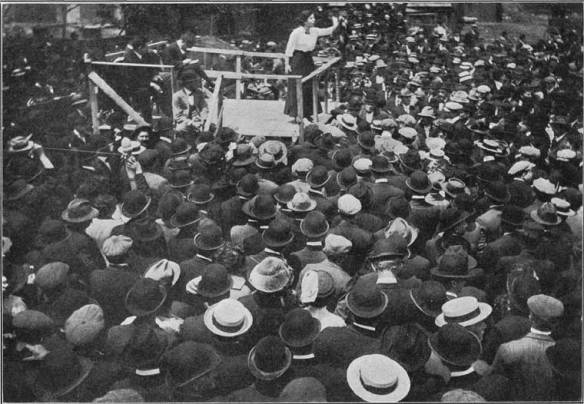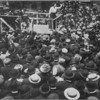Where Gumbo Was #462
The Paterson Museum is steps away from the Great Falls of the Passaic that gave the city its birth and purpose as America's first intentional industrial city. That history is reflected in many of its exhibits from key industries including locomotive-building and especially textiles.
But like many 'home town' museums, it left me feeling that big parts of the story were missing, that the collection was guided by what was available and not by stories of people who lived there and used it. That struck me particularly because the five-month 1913 silk workers' strike in Paterson is one of the key moments in American labor history—and the museum has no trace of it!
 IWW organizer Elizabeth Gurley Flynn speaks to striking Paterson silk workers
IWW organizer Elizabeth Gurley Flynn speaks to striking Paterson silk workers
That said, the museum is an enthusiastic speaker for everything Paterson. When I visited, that even included a retired Paterson teacher, a former high school cheerleader (in costume) who gave an enthusiastic (and nearly unavoidable) introduction to growing up in Paterson in the 1950s and local high school sports history.
Not that the town's high school sports history is without note; Larry Doby, the first Black player in the American League was a standout four-sport letterman in his high school days (and played minor league pro ball under a pseudonym while still in school)
Another Paterson native, less well-known in the sports world, was Lou Costello, who was a stand-out basketball player, the local and state free throw champion. Costello returned to town regularly to support local youth leagues.
Long before Alexander Hamilton and the Society for Establishing Useful Manufactures focused on the power of the Great Falls, they were an active fishing grounds for the Lenape tribes in the area, and the museum's path through its exhibits starts there with a display of their agricultural tools.
The S.U.M., led by Hamilton and backed by George Washington (who had visited the area during the Revolutionary War) was interested in developing American industries that could compete successfully with Britain's, freeing the new nation from dependence on the former colonial overlords.
The key to their plan was to divert the water falling with great force over the falls into a series of rapidly-flowing raceways at the lower level; the raceways provided power to water wheels to run factories. One of the raceways can be seen next to the road in the bottom right of the picture.
The building in the foreground is a hydro-electric plant built early in the 20th century to provide constant power even when water levels were low.
Many kinds of industries developed around the falls, and the raceways were extended and expanded over the years. One of the larger-scale industries in the area was building locomotives for the rapidly-expanding American railway system. Rogers was one of the biggest, and the museum is located in the building marked 'Erecting Shop' in the engraving above.
When the last spike was driven in 1869 to complete the transcontinental railroad, it was a Paterson-built Rogers locomotive that pulled the westbound train. Incidentally, the eastbound train was pulled by an engine built in Schenectady, New York, and then shipped in parts to San Francisco.
There's a large collection of machine tools used in Paterson factories or built there for others. Some were invented by Paterson pioneers such as John Royle, whose company still exists.
A machinist's tool chest—entrepreneurs owned the factories, but skilled machinists owned and carefully guarded their tools. In the museum, it's "Please Do Not Touch;" in the factory the rule was the same, but likely less polite!
Textile manufacture, and especially silk, has had the longest history in Paterson; the S.U.M. from the beginning saw silk as a key industry to compete in and started out by planting mulberry trees to serve as homes for silkworms. That soon came to an end (wrong climate and wrong variety of mulberry) so the mills turned to importing the raw material.
Cotton weaving also found a home in Paterson, and several mills produced Jacquard fabrics. These are intricately patterned fabrics that are the product of what is arguably the world's first computer used in manufacturing. Before its invention in France in 1804, only the most skilled weavers could slowly produce intricately patterned fabric.
Jacquard invented a system to control the loom by a series of punched cards that were fed through a reader, sending the right thread through the cloth at the right point.
By the time locomotive manufacture was beginning to fade, Paterson had a new contender: aircraft engines. A merger of several early companies created Wright Aero, whose owners included the Wright Brothers and other aviation pioneers including Glenn Curtiss and Glenn Martin. The factories produced thousands of engines for military and commercial planes before it closed in 1946. During World War II, 24,000 worked there.
And since we've dealt with land and air transport here, it's only fair to turn to the sea for a moment, and John Holland, an Irish schoolteacher and inventor who came to America as a teacher, until he began designing submarines. His first was on a commission for the Fenians, an Irish nationalist group that wanted to use it against British navy ships. He worked in Paterson.
That didn't work out, but Holland continued on the submarine trail, and ended up inventing the modern submarine; his sixth prototype was sold to the U.S. Navy and became the pattern for many more. British and other navies also followed the Holland pattern, as seen below.
Samuel Colt was another Paterson manufacturer; the museum has a display of more kinds of Colt revolvers than you could believe existed, ranging from quite small to nearly too-long to use with one hand.
Some of the exhibits speak more to local enthusiast's collections than to the city's industrial history, including a large collection of patent medicines from early in the past century, as well as a number of pharmaceutical and health posters collected by a local pharmacist.
Also in the mid-20th century, Paterson's Hinchcliffe Stadium was home to auto racing as well as local sports. There's a gallery of racing memorabilia and auto-related equipment to remember it by, as well as these model racers.
I was especially taken by two sculptures by Michael Malpass. I'm not sure what brought the works to Paterson, since Malpass was not local, but they feel like they belong there. Malpass wrote of his work "From the discards of society I simply try to create a beautiful object. I am definitely near the Rubicon, making shapes that no one has seen before, from metal used for thousands of years." Below, Tool Ball and Theta III, both from the 1980s.
A short walk away, at Overlook Park, Alexander Hamilton looks over the falls. The falls themselves, aside from their industrial use, have been an attraction for many years, and even the scene of stunts as varied as Sam Patch's 1827 leap over the falls (repeated several times before he moved on to Niagara) and tightrope walks.
Harry Leslie did the walk in 1879, and then retreated, backwards, to the center of the rope, set up a table, and ate a meal. Philippe Petit did it again 95 years later, in 1974, as part of the Great Falls Festival. But he skipped the dinner.
Paterson Museum and Paterson Great Falls National Historical Park are open most days, and admission is free. But since bad weather may close either, it's best to check their websites before heading out!
And congratulations to George G, this week's only correct solver.


Comments (0)